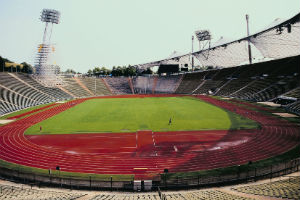Securing a stadium is complex, not just because of the several different technologies involved, but also because of the large numbers of people who gather there. The technical intricacies of managing security at stadiums make it vital that professional systems integrators handle this vertical.
Securing a stadium is complex, not just because of the several different technologies that need to be integrated, but also because the large numbers of people gathering there increase the potential threats. The technical intricacies of managing security at stadiums make it vital that professional systems integrators (SI) handle this vertical.
From an SI’s perspective, this is a good opportunity to diverge their business into, but unlike several other verticals, there are certain unique points to take note of.
Ensuring the right resources to meet the needs
Considering the complex nature of integrating devices in this vertical, SIs have to make sure they have the resources to provide what the situation requires. Dan Donovan, VP of Sport & Entertainment at Guidepost Solutions, a consultant involved in securing the University of Phoenix Stadium which hosted the Super Bowl this year explained the criteria that were used to select SIs for the project.
 Securing training areas is also an important
Securing training areas is also an important
part of providing security for sports events.
“Once the design was complete we conducted vendor reviews and developed the request for proposal (RFP) for SIs and vendors to respond to,” Donovan said. “The integrator was selected based on their solution, experience working in the building, and the systems they recommended to meet the overall design requirements.”
Not many companies know this as well as Johnson Controls, who installed and integrated building systems for world soccer championship in Brazil in 2014. Subramaniam Jeeva Subbiah, Building Technology and Services Manager for Building Efficiency at Johnson Controls Asia pointed out that the difficulties involved had to be managed with utmost care.
“The integration has to be carefully thought through,” Subbiah said. “For example, if a fire alarm detects smoke in the stadium, that alarm triggers a series of immediate events. Law enforcement is notified. Surveillance cameras will turn to focus on the area. The heating, ventilation and air-conditioning (HVAC) system immediately turns off air flow to weaken the fire. Gates and access doors automatically open as a mass notification system alerts fans and provides direction to exit the facility.”
Top requirements when securing sports events
 Security solutions should let fans feel safe
Security solutions should let fans feel safe
enough to enjoy the game.
When providing security services to sports events with large crowds, the goal is not just to ensure safety but to make sure that the people feel safe-enough to enjoy the game. Emphasizing this point, Andre Leitao from Bosch Security Systems said that a proactive effort is the only answer to this problem.
“Fortunately, over the last years the number of incidents has reduced dramatically after major improvements in the infrastructures, technology and experience,” said Leitao.
“However, while most stadiums enjoy a clean sheet, the risk awareness is also decreasing and concerns with security go along. Therefore, defining and following strict standards is paramount. International and national sport associations and governmental agencies have been very busy with this and shall continue.”
Challenges for systems integrators in this vertical
For the world soccer championship in Brazil in 2014, Johnson Controls designed, installed and integrated dozens of systems, including video surveillance, access controls and fire alarms. Integrating several different devices to the modern-day requirements was a crucial part that posed a significant challenge.
 Integrating several devices to modern-day
Integrating several devices to modern-day
requirements is a major challenge.
“Priority considerations include accessibility, crowd control and safety,” Subbiah said. “Stadium design now places a huge emphasis on ensuring the safety of spectators as a result of several major incidents during football matches. Energy efficiency and sustainable design is also becoming increasingly important.”
To complicate the integration process, not all sections of stadium and its allied areas may be constructed at the same time. Even if a main stadium is ready for an event much ahead of schedule, sections like training sites and the accommodation areas may be finished only at the last minute. Such a race against time often poses considerable difficulties to the SI’s work.
To top it all, challenges may not just be technical. Considering the scale of such events and the variety of parties involved in its organization, there may be several kinds of hindrances to completing the project.
“There are many stakeholders involved and many experts needed for a complex project,” Subbiah said. “It is critical to include key stakeholders and experts from the design stage to avoid silos. For example, a senior team needs to come together at an earlier stage to decide on a comprehensive security policy that covers both physical and logical security.”
New and upcoming trends in stadium security
José López Martin, Senior VP of Indigovision in Latin America, has significant experience in sports events security as the company had played a major part in securing the 2014 soccer world cup in Brazil. According to him, the major change that’s seen over the years is the increase in the number of cameras and the technology required to manage them simultaneously.
 Non-instrusive security solutions ensure fans
Non-instrusive security solutions ensure fans
enjoy the game without concerns.
“For instance, eight years ago a stadium was monitored by 80 cameras, but today as much as 400 or more cameras do the job,” Martin said. “To monitor such huge loads of data that come in, either you need to have lots of people in the control room, or ideally, there should be intelligent technology that will inform you when something needs attention.”
Donovan concurs to this idea, adding that there is a change in perspective when it comes to the security requirements for sports events.
“Over the years, there has been an increase for video surveillance needs for major events from a proactive crowd management point-of-view to an incident response point-of-view and from a reactive ability to understand specific incidents because we have captured them on video,” Donovan said.
Moving towards non-intrusive security systems
In short, while the demand for higher resolution images and the bandwidth to support it would continue into the future, what would really make the difference are intelligent analytic systems that could simplify the process of surveillance. But there are also concerns that more cameras could make spectators feel intruded. Hence the trend is to move towards a system that would blend-in with the background and yet let people feel protected. In Leitao’s words, security should be (and is) reinventing itself to turn into supporting the fan experience – rather than interfering with it.